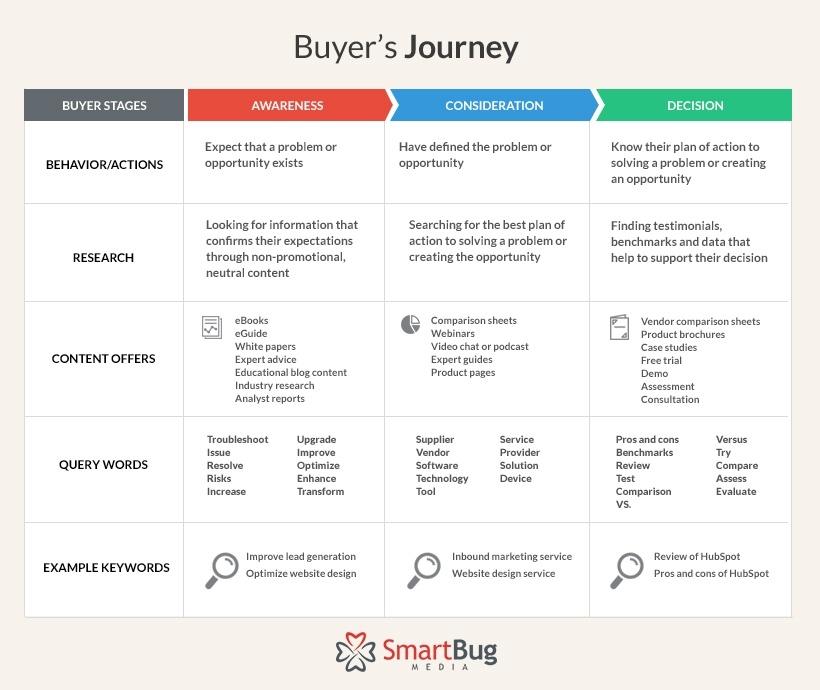
5 Steps to Start Web UX Personas Mapping
July 25, 2016
By Hansen Hunt
There are two Web UX mapping situations you can be in: First, you have a brilliant idea and the passion to start a new business but haven’t done any sort of UX personas mapping yet. Second, you are established and have been operating your business for some time but realize that you never truly considered your buyer personas and their journey when developing content, collateral, and products/services.

For the new business, the time to start is now, before you spend money on building a website. For the latter, it’s never too late to start. Maybe you have vague buyer personas, but they aren’t used in your everyday decision-making and content. Regardless of where you stand, the more in depth you go when mapping UX for your personas, and the earlier you start, the easier it will be to communicate with your customers throughout their entire journey and ultimately turn site visitors into leads and customers.
What Goes Into UX Mapping for Your Personas?
Step 1: Buyer Personas
This is a discovery process that you must go through to understand who your primary customers are and how you can help them. The process should involve real research through conducting interviews both internal (with sales and support teams, at a minimum) and external (with customers), analyzing your analytics and reports, researching relevant and popular content topics in their industry, and even sending out surveys. At first, you can start by brainstorming, but then you must back it up with data from your research. Don’t worry—you can test and adjust as time goes by and you gather more data.
There are extensive guides to developing your buyer personas (including The Ultimate Guide to Inbound Marketing Personas), but here is a quick list of what you will need to identify for each customer type (i.e. persona). Pro tip: Ask tons of “why” questions through the discovery process to uncover the motives behind their behaviors.
- Demographics – Go deeper than their job profile and income; ask questions about their hobbies and priorities in their personal lives.
- Role in the organization – Their role will often determine how they will be using your product or service on a daily basis and also their role in the decision making process.
- Goals – What are they trying to achieve? How can you help them reach their goals, both personally and professionally?
- Challenges and pain points – What are the primary and secondary challenges to this individual meeting their goals? This section should include any emotions they experience.
- Objections – What is keeping them from buying what you offer? You should understand the different types of objections from each persona.
- Watering holes – You need a good understanding of where your personas are hanging out online and in real life. Do they attend several industry events? Do they engage on LinkedIn Groups?
- Quotes and testimonials – A real example, in the customer’s words, about your product or service will help you gain insight into what they truly think of your product.
Step 2: Buyer’s Journey
Now that you have defined and understand who your personas are, the next step is to map out each of their “buyer’s journeys,” the path a person takes to purchase your product or service. There are multiple ways you can set this up, but the simplest form is to map each persona with the following three stages.

There are numerous resources to help you with developing the buyer’s journey for each of your personas. After you have completed both, you are ready to audit what content you have and how that helps each persona in all three stages of their journey.
HubSpot uses an example of how this would work for a soon-to-be bride and the journey she is going through making a venue decision for her wedding:
- Awareness Stage: “I am a bride who always dreamed of a hometown wedding.”
- Consideration Stage: “I am a bride considering all possible alternatives to a hometown wedding.”
- Decision Stage: “I am a bride making a long list of potential destination wedding venues, whittling that long list to a short list and ultimately making a decision.”
Step 3: Content Inventory and Aligning With the Buyer’s Journey
Now that you understand the journey your customers are going through when considering and purchasing from you, it’s time to see what content you have or need to create for each touch point in the process.
Perform a Content Audit
The best way to get started is to find every piece of content you’ve ever created. If you are just starting out, this will make life easy. Otherwise, set some time aside to fill out an Excel sheet with all of your content and then categorize each piece with the following information:
- Target Persona: Who is this content relevant for?
- Stage in the Buyer’s Journey: Where will that persona be in their journey?
- Title/Author/Publish Date
- CTA: The copy for that piece of content’s CTA and even a CTA for what content offer will come next.
- Target keyword for your content (not always relevant, but it's good practice to include).
- Action Item: Does your content need to be revised? Is it evergreen? Maybe a quick edit and republish are all you need.
Here is a quick snapshot of a template I’ve used successfully in the past. Sometimes I add in the URL where the content is located and another column for “content type” so that I can easily sort by e-books, case studies, videos, etc. HubSpot also has a complete set of resources for mapping content to the buyer’s journey.

Types of Content to Include in Your Audit:
- E-books
- Case studies
- Videos
- Webinars
- White papers
- PowerPoint decks (internal and external)
- Outdated content
- Blog posts
- Editorials (including published elsewhere by your team)
Step 4: Content Creation
Now that you have identified all of your content assets and mapped them to the buyer’s journey, the next step is to identify the gaps in content. For example, you have zero pieces of content for Mark the Manager in the decision stage. At the same time, you’re a little light on awareness-stage content for Cesar CEO. Now, you may not have a million content writers on your team, so prioritize which persona’s buyer’s journey you want to complete first and start tackling one gap at at time.
Always remember when you are creating content and filling these “gaps”; the goal is not to simply fill the gaps, but to create content that answers your prospect’s questions, relieves their biggest pain points, and ultimately takes them one step closer to their goals. You’re creating content for your customer, not for your company.
“Your customers don’t care about you. They don’t care about your product or service. They care about themselves, their dreams, their goals. Now, they will care much more if you help them reach their goals, and to do that, you must understand their goals, as well as their needs and deepest desires.” — Steve Jobs
Steps for Creating New Content
- Decide on topic and format: Find out what your prospects are searching for, see what topics are popular at industry conferences, and see what your competition is writing about. You should be able to come up with a list of potential topics.
- Write a creative brief: Write a creative brief mapping out your strategy and goal with the content.
- Write and edit the content: Write a draft and then do some extensive editing. Eliminate the fluff and any repetitive ideas and clean up the vocabulary/grammar. Grammarly is a fun and free tool to help you in the editing process.
- Design: Depending on the content format, you will need to gather images, branding materials like logos, and possibly a template to start with in order to turn your copy into a visually appealing piece of content. Visuals are extremely important for increasing clicks to your content and helping people navigate it easily, so don’t take this step lightly.
Step 5: UX Personas Mapping on Your Website
Finally, you have gathered the content you need and know whom it’s for and where in their buyer’s journey to send it to them. Now, how do you implement what you have gathered on your website? Here are 18 ways you can do UX mapping for your personas on your website:
Web UX and Site Architecture
If you are starting a new Web project, you have a great opportunity to think about the UX when laying out the site architecture. What to consider:
- What content to display prominently on your primary-site Web pages
- Where the CTAs will be positioned on templates
- What content aligns with the targeted keywords for each page
- What pages are relevant for one persona and should have unique content specific to their goals
- Home-page persona content that helps people easily navigate to pages related to their interests
- Which personas are most likely to need the information on which pages
Persona Pages
As long as each of your personas is well defined and has unique pain points and objectives, you can quickly create entire pages for each persona. On these pages, you can serve up content that speaks directly to a persona's goals, which will lead to a higher CTR and visitor-to-lead conversion rate than if the page was generically built for all personas. What you can include on the persona pages:
- Persona-specific value proposition
- Copy related to their pain points, and how your product/service specifically can help them
- Information on products and services that the persona would be most interested in
- CTA for relevant content
- Recent blog posts relevant to the persona’s interests
- Testimonials from customers that match the same persona
- Case studies relevant to the persona
Smart Content and CTAs
One of the most powerful UX tools for marketing to your personas is the ability to personalize your website content being displayed, depending on different criteria. Here are a few ideas for using smart content:
- Persona: The most important segmentation for smart content and CTAs is to use HubSpot smart lists to identify personas and then serve them persona-related content as they browse your entire site. You can set up and designate a specific section on your site pages to be “persona content," which can change depending on who is visiting the page or simply show a default piece of content if the persona is not known.
- Buyer’s Journey/Lifecycle Stage: New visitors are likely still in the awareness stage of the buyer’s journey and should not be shown content that is too sales- or product-focused. Instead, focus content around their search term and pain points. If the visitor is already a Sales-Qualified Lead (SQL), you can set up smart content to display more product information, pricing, and other intent/decision-level content such as “request a demo” instead of “download e-book."
- Previous Actions Taken: One of my favorite tactics is to use smart CTAs that change depending on whether or not the contact has downloaded a certain piece of content. For example, if they download the awareness-stage e-book, the next time they visit the website, they will see the consideration-stage offer associated with that campaign.
- Forms: Progressive profiling utilizing smart fields on forms eliminates the need for visitors to fill out unnecessary fields that are already known in your CRM. For example, if you already have their phone number or company name, you don’t need to ask them for it again. By doing this, users won't get frustrated inputting the same information over and over again—plus, you get to know them better, which means you can continue serving them more tailored content.
- CTAs: Aside from using smart CTAs to display different content depending on what actions they have previously taken, you can also use smart CTAs to conduct A/B tests to see what messages resonate better with your audience and optimize CTR performance.
At the end of the day, you should continue testing and optimizing to ensure that what content you have displayed is relevant to your audience. You can determine this based on average CTRs, time on page, bounce rate, and visitor-to-lead conversion rates. To accomplish this in the planning stages, you can have a few of your persona contacts navigate your website while you watch and record their actions.
Start UX mapping for your personas from day one, before building a website, or start now if you already have a website in place. The more tailored your site is for each individual, the more your visitors will feel like you care about their goals, and they will find your content useful.

About the author
Hansen Hunt was formerly a Senior Consultant at SmartBug Media. He has been a believer and practitioner of inbound marketing for 11+ years. He geeks out on craft beer, has an insatiable travel bug, and is passionate about helping people and companies pursue their purpose. His success across a broad range of industries and eagerness to solve the most challenging problems equips him to develop creative strategies and drive growth for clients. Read more articles by Hansen Hunt.









